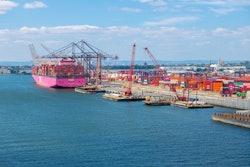As the International Longshoremen’s Association initiated a strike across East and Gulf coast ports on Tuesday, experts weighed in on its implications, ranging from financial losses, labor and capacity restraints, and other cascading effects.
The impact of the strike on the industry would be sizable, said David Dvinov, COO of New Jersey-based DapeCon Trucking. Customers are unwilling to absorb additional costs for storage and extra charges, adding that that it would be an uphill battle to recover expenses incurred while making necessary plans for the strike.
Dvinov said his company has had to increase its parking footprint. It had been quite costly to “park all the containers that got stuck because of a slow-working port and then eventual closure,” he said.
When the terminals closed, Dvinov said it created a mousetrap effect of containers. “We weren’t able to return containers, so that pushed the demand to store those containers. That’s what we had to deal with. On top of that, we had to make concessions. We’re also probably going to have to issue some type of mechanism to help support our drivers.”
The situation is also compounded by the impact of a significant downturn in the trucking market since February 2023, which pushed margins and rates, and with the new challenges would also inflict revenue loss, Dvinov said. “We’re having a hard time so far passing these added costs onto our customers.”
Similarly, Dvinov also pointed out how smaller trucking companies won’t have the ability to go after a larger footprint of storage on demand. “They are probably going to take the brunt of the impact because they don’t have the reserve of containers that could be pre-pulled, picked up from the port, and then stored in a yard.”
Consequently, when the ports open back up, Erik Rosica, sales supervisor for OEC Group, noted that there would be a backlog of congestion from unloading all the containers.
“You’re going to see poor congestion charges for a long time, and it might seem like there aren’t enough carriers to handle the immediate backlash of this strike with the excess containers that’ll be left at the port.”
[RELATED: Port strike creates 'opportunities' for spot market carriers]
Congestion, lack of equipment, lack of yard space, capacity constrictions, and vessel congestion will stress every supply chain, said Paul Brashier, vice president of global supply Chain for ITS Logistics.
“As was seen during the days leading up to the strike, driver productivity dropped significantly. Drivers that could pull six containers or more per day prior were only able to get one to two containers per day out of the port," he added. "Ultimately, shippers should be prepared to add a minimum of three to five times the number of drivers to their current network. It should also be noted that for every 36 hours the ports are closed, port operations will be negatively impacted for one full week.”
Prolonged impact
Dvinov said the worst-case scenario would be a forced resolution for the labor to be forced back to work, resulting in an unofficial slowdown, which has already been prevalent. As a New-Jersey based intermodal operator, Dvinov commented that there’s been tremendous backlogs that have been consistently steady, especially in the Port Newark Container Terminal (PNCT).
David Spencer, vice president of market intelligence at Arrive Logistics, pointed out that the duration of the strike is going to be a major driver from a slowdown perspective.
Spencer said an extended strike is initially going to mean a slowdown in truckload demand from an import-export perspective. However, looking into the next few weeks, there would be a lasting, meaningful impact from slowdowns from everything to just-in-time manufacturing nationwide, to auto parts, plastics, furniture, and building materials that are largely tied to East and Gulf coast ports' volumes.
A slowdown in demand creates an inflated capacity environment, which could put downward pressure on freight rates, Spencer said. The longer the strike lasts, there is a potential for an increase in freight rates that could stem from working through backlogs.
Spencer compared it to the similar rates activity seen in the early days of COVID. “The pandemic sort of led to a demand pullback followed by a surge in demand, which led to increasing rates," he said.
Rosica added there could also be companies that would be marking up prices to leverage the situation. “I expect rates to soar, maybe not immediately, but in a month’s time, I expect them to be significantly higher than they are today.”
Adjusting for possible challenges
As carriers prepare for its impact, Spencer suggested being flexible in rerouting to alternative areas and keeping customers in mind and how they would be affected.
“One of the things we’ve done, while we’re not necessarily an asset carrier, but our volumes depend on it, is understanding the shippers that we work with. How are their operations going to be affected by a slowdown after three days or after two weeks? How is it going to affect the regular volumes that we see so we can be forward and proactive in planning for how to best utilize our assets and equipment?”
The best thing a company can do is get an accurate understanding of what your demand is going to be and how that’s going to be affected in the days and weeks ahead, Spencer said.
Rosica said companies need to do their due diligence and make sure end customers aren’t affected by the extra congestion. Once there’s more information on the expected duration of the strike, planning is key – from the number of drivers to the number of loads that are still at the terminal that will need to be pulled out and working with the other stakeholders to ensure its efficiency.
“Make sure you have sufficient workforce and a game plan worked out,” Rosica said. “It’s going to be a slow start. Keep your end customers informed; stay in communication. That’s the most valuable asset that we have right now – information sharing.”
Besides customers, Dvinov said retention of drivers is critical too.
“When the strike is over, we need to be able to have the confidence of our fleets," he said. "It’s just a matter of doing the right thing, not price gouging.”
Dvinov added it’s also important to offer support for independent owner-operators and company drivers that are not going to be earning in the meantime.
“At the end of the day, the folks that are getting impacted the most are the actual blue-collar truck drivers that depend on that salary.”













